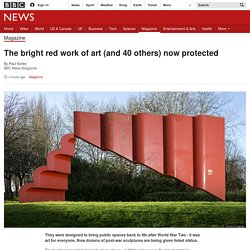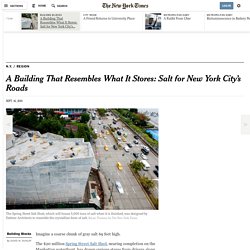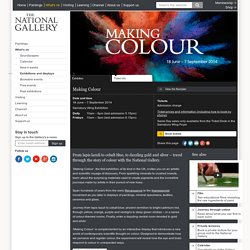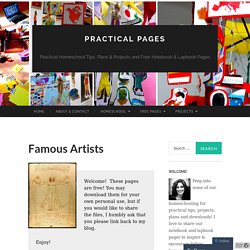

Fait désormais partie dâVerizon Media. Fait désormais partie dâVerizon Media. Fait désormais partie dâVerizon Media. Julie Burstein: 4 lessons in creativity. Van Gogh exhibition in Chicago to feature all three "bedroom" paintings. Chicago. Alexander Calder. The bright red work of art (and 40 others) now protected. Image copyright Historic England They were designed to bring public spaces back to life after World War Two - it was art for everyone.

Now dozens of post-war sculptures are being given listed status. The bright red welded steel structure above - at Milton Keynes in Buckinghamshire - appears to defy gravity and the rules of balance. It was created in 1970 by Bernard Schottlander. He fled Nazi Germany in 1939 for Leeds, where he worked in a factory as a welder while attending evening classes in sculpture. Working with Historic England, the government has now given his sculpture added protection.
Scroll down and see the 40 other artworks granted Grade II or Grade II* status across England. Knife Edge Two Piece by Henry Moore, 1967 Westminster, London This piece is typical of the monumental abstract bronze sculptures which characterised the late career of Moore - one of England's most important avant-garde artists. Daily Art Fixx - Art Blog: Modern Art, Art History, Painting, Illustration, Photography, Sculpture — Art and the art world. Art History Today. Be More Creative: 7 Things to Learn From Leonardo da Vinci. I'm going to go out on a limb here and say that since his death, the world has never really had another Leonardo da Vinci.

While his name might conjure up images of famous works of art such as the Mona Lisa, The Last Supper, or The Vitruvian Man, he was much more than an artist. In fact, he was an architect, musician, mathematician, engineer, inventor, expert in anatomy, geologist, mapmaker, and botanist. In short, he was a genius. Genius and creativity are closely linked.
How does one make connections that have never been made before? Michael Gelb--someone who makes his living teaching companies how to innovate--has written 13 books on creativity and innovation. Gelb says the fodder for his book came from studying Leonardo's notebooks. Here's what Gelb learned from the Italian master about what you need to be most creative. Curiosity Children are curious by nature, but as we grow up much of our inquisitiveness ebbs. "Almost all children in their natural state ask lots of questions. Process Infographic, Infographic and Student. Cultural Institute. Some students built a giant wooden megaphone so they can listen to the forest. Shona Sculpture Process. Musa Cancun English site.
A Building That Resembles What It Stores: Salt for New York City’s Roads. Photo Imagine a coarse chunk of gray salt 69 feet high.

The $20 million Spring Street Salt Shed, nearing completion on the Manhattan waterfront, has drawn curious stares from drivers along West Street and from pedestrians and bicyclists in Hudson River Park. Folded, creased, dimpled and chamfered, its windowless, enigmatic facade is like a monumental work of origami. But once you know what it is — a concrete shed where 5,000 tons of de-icing salt for the roads of Lower Manhattan will be stored this winter — you’ll have a hard time getting the image of a giant salt grain out of your mind. “In some ways, it’s the simplest building I’ve ever designed and in some ways, it’s the most complicated,” said Richard Dattner, 78, who founded Dattner Architects 51 years ago.
The complexities begin with politics, because the shed is associated with the enormous — and enormously unpopular — Department of Sanitation garage across Spring Street, which Mr. Mr. Ms. Mr. “They will wonder,” Mr. Photo Mr. Ms. Exhibitions and displays. From lapis lazuli to cobalt blue, to dazzling gold and silver – travel through the story of colour with the National Gallery.

‘Making Colour’, the first exhibition of its kind in the UK, invites you on an artistic and scientific voyage of discovery. From sparkling minerals to crushed insects, learn about the surprising materials used to create pigments and the incredible journeys made by artists in their pursuit of new hues. What Is a Print? Your Paintings. Art Lesson: Claes Oldenburg. TEDxSMU 2011 - Jaume Plensa - Art & Form. Anthony Howe's Otherworldly Kinetic Sculptures. Writing an AP Art History essay. Practical Pages. Welcome!

These pages are free! You may download them for your own personal use, but if you would like to share the files, I humbly ask that you please link back to my blog. Enjoy! MUSEUMS WORLDWIDE CLASSIC & MODERN. Art and Art History. Vitrix Hot Glass Studio. Tara Donovan. Stone carving of Chinese artists. The Making of a Marble Sculpture. Incredibly Amazing Ice and Snow Sculptures. Highlights No1-Sculpture by the Sea Bondi 2013. Time-lapse highlights of Sculpture by the Sea, Cottesloe 2014. Sculpture Techniques. Bronze casting Patinated bronze plaque, Solomon and the Queen of Sheba, Giuseppe Piamontini, about 1700-10.

Museum no. A.32-1959, © Victoria and Albert Museum, London Bronze is an alloy of copper and tin, and often also contains lead or zinc. It is strong and durable but can also capture the fine, complex detail within a casting mould. Bronze has been used in Europe since antiquity to produce tools, weapons, sculpture and decorative works.
There are two basic methods of casting a bronze. In the 'direct' method, the original wax model is used and therefore destroyed. Explore bronze objects in Search the Collections Video: How was it made? View transcript of video This video is silent This video shows one method of casting a figure in bronze. This is repeated until the wax is the desired thickness. The bronze is skimmed to remove impurities. Stone carving. Fun Crazy Kinetic Sculpture Race in Baltimore - Video. Socrates Sculpture Park, Historical Overview. Art History.